Public Art Proposal Display
Untitled
Suhas Bhujbal
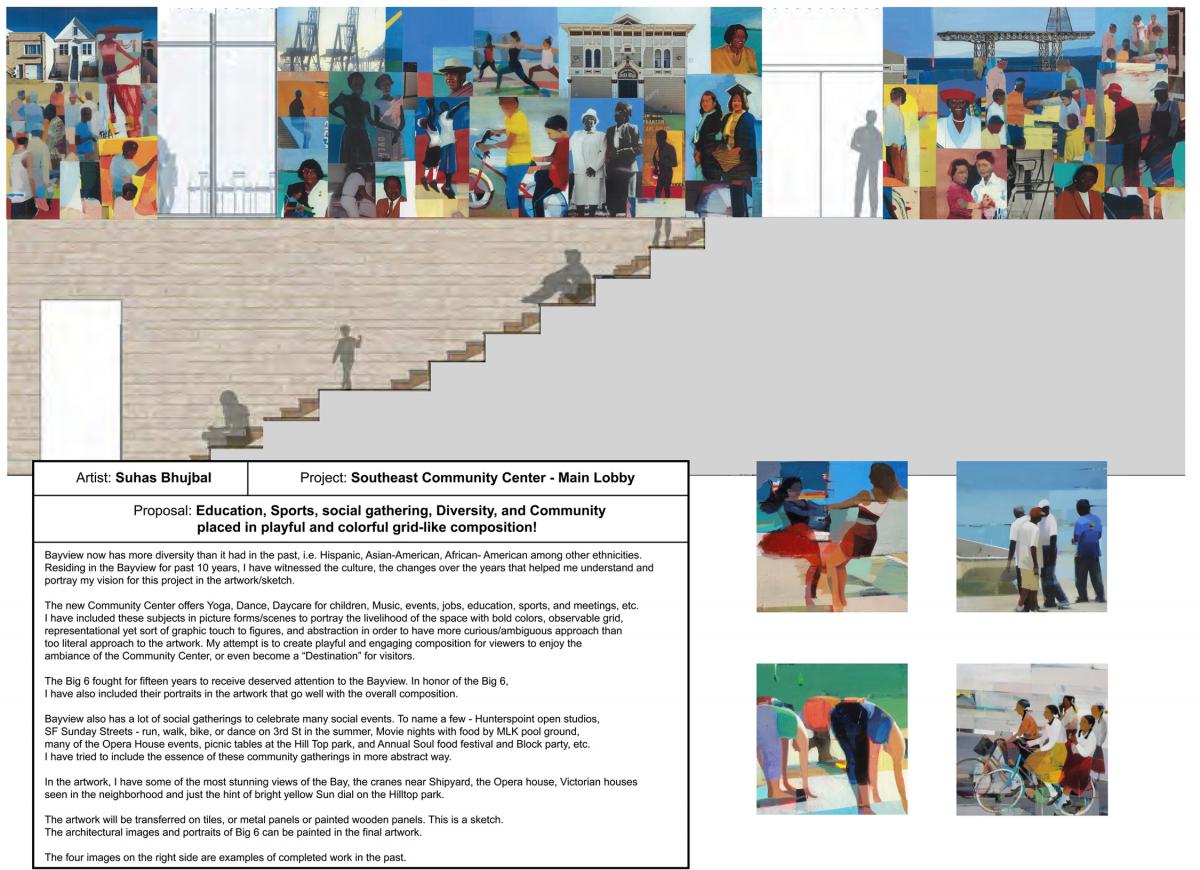 Bayview now has more diversity than it had in the past, i.e. Hispanic, Asian-American, African- American among other ethnicities. Residing in the Bayview for past 10 years, I have witnessed the culture, the changes over the years that helped me understand and portray my vision for this project in this artwork/sketch.
Bayview now has more diversity than it had in the past, i.e. Hispanic, Asian-American, African- American among other ethnicities. Residing in the Bayview for past 10 years, I have witnessed the culture, the changes over the years that helped me understand and portray my vision for this project in this artwork/sketch.
The new Community Center offers Yoga, Dance, Daycare for children, Music, events, jobs, education, sports, and meetings, etc. I have included these subjects in picture forms/scenes to portray the livelihood of the space with bold colors, observable grid, representational yet sort of graphic touch to figures, and abstraction in order to have more curious/ambiguous approach than too literal approach to the artwork. My attempt is to create playful and engaging composition for viewers to enjoy the ambiance of the Community Center, or even become a “Destination” for visitors.
The Big 6 fought for fifteen years to receive deserved attention to the Bayview. In honor of the Big 6, I have also included their portraits in the artwork that go well with the overall composition.
Bayview also has a lot of social gatherings to celebrate many social events. To name a few - Hunters Point open studios, SF Sunday Streets - run, walk, bike, or dance on 3rd St in the summer, Movie nights with food by MLK pool ground, many of the Opera House events, picnic tables at the Hill Top park, and Annual Soul food festival and Block party, etc. I have tried to include the essence of these community gatherings in more abstract way.
In the artwork, I have included some of the most stunning views of the Bay, the cranes near Shipyard, the Opera house, Victorian houses seen in the neighborhood and just the hint of bright yellow Sundial on the Hilltop Park.
The artwork will be transferred on tiles, or metal panels or painted wooden panels. This is a sketch. The architectural images and portraits of Big 6 can be painted in the final artwork.
View a larger image of the proposal.
Untitled
Emory Douglas
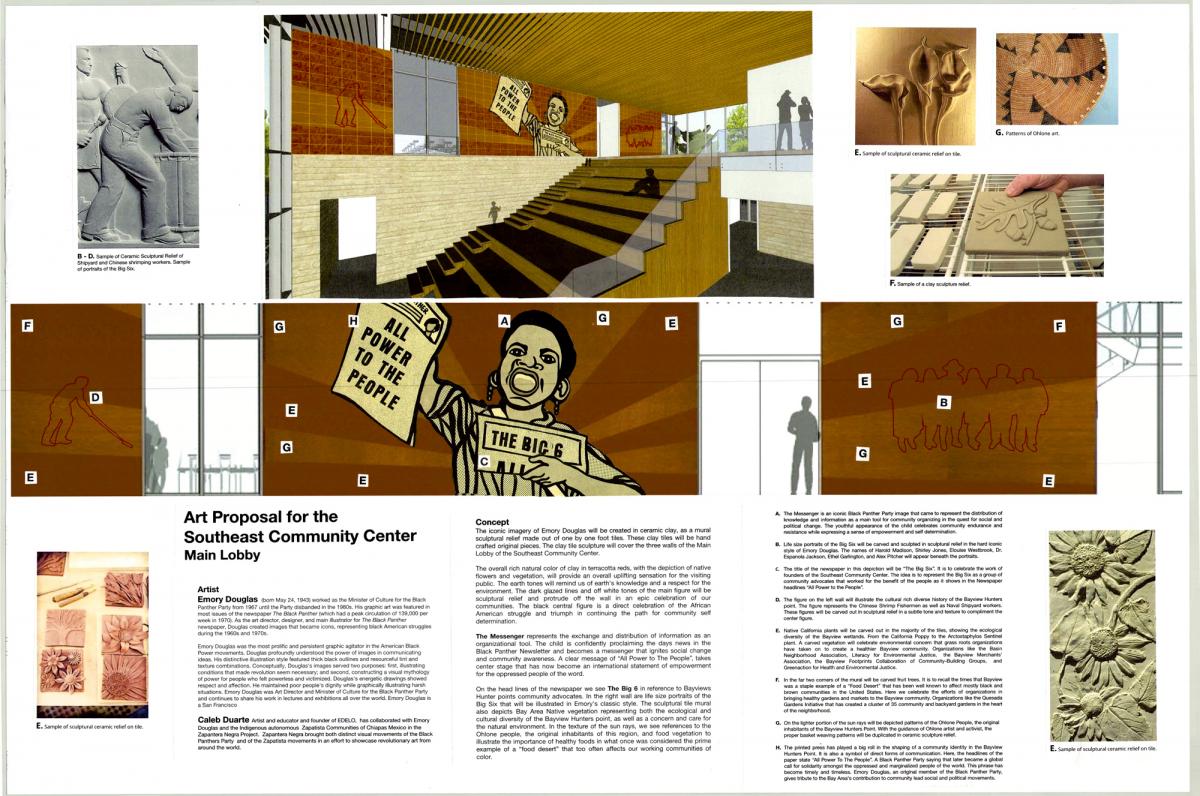 The iconic imagery of Emory Douglas will be created in ceramic clay, as a mural sculptural relief made out of one by one foot tiles. These clay tiles will be hand crafted original pieces. They will cover the three walls of the Main Lobby of the Southeast Community Center.
The iconic imagery of Emory Douglas will be created in ceramic clay, as a mural sculptural relief made out of one by one foot tiles. These clay tiles will be hand crafted original pieces. They will cover the three walls of the Main Lobby of the Southeast Community Center.
The overall rich natural color of clay in terracotta reds, with the depiction of native flowers and vegetation, will provide an overall uplifting sensation for the visiting public. The earth tones will remind us of earth's knowledge and a deep respect for the environment. The dark glazed lines and off white tones of the main figure will be sculptural relief and protrude off the wall in an epic celebration of our communities. The black central figure is a direct celebration of the African American struggle and triumph in continuing the path for community self determination.
The Messenger represents the exchange and distribution of information as an organizational tool. The child is confidently proclaiming the days news in the Black Panther Newsletter and becomes a messenger that ignites social change and community awareness. A clear message of “All Power to The People”, takes center stage that has now become an international statement of empowerment for the oppressed people of the word.
On the head lines of the newspaper we see The Big 6 in reference to Bayview Hunter points community advocates. In the right wall are life size portraits of the Big Six that will be illustrated in Emory's classic style then depicted in sculptural relief by sculptor Caleb Duarte. The sculptural tile mural will depict Bay Area Native vegetation representing both the ecological and cultural diversity of the Bayview Hunters point, as well as a concern and care for the natural environment. In the texture of the sun rays, we see references to the Ohlone people, the original inhabitants of this region, as well as food vegetation to illustrate the importance of access to healthy foods in what once was considered the prime example of a “food desert” that too often affects our working communities of color.
The background of the center figure will have Emory Douglas iconic sunraze that became a symbol of powerful resistance in the form of a positive light. What decorates the sunraze will be sculptural relief of Native Bay area plants, specifically those found in the Wetlands of Bayview. The diversity of the plants will reflect on the cultural diversity of the Bayview community.
Specific symbolism for each section of the Sculptural Mural
The Messenger is an iconic Black Panther Party image that came to represent the distribution of knowledge and information as a main tool for community organizing in the quest for social and political change. The youthful appearance of the child celebrates community endurance and resistance while expressing a sense of empowerment and self-determination.
Life size portraits of the Big Six will be carved and sculpted in sculptural relief in the hard iconic style of Emory Douglas. The names of Harold Madison, Shirley Jones, Elouise Westbrook, Dr. Espanola Jackson, Ethel Garlington, and Alex Pitcher will appear beneath the portraits.
The title of the newspaper in this depiction will be “The Big Six.” It is to celebrate the work of founders of the Southeast Community Center. The idea is to represent the Big Six as a group of community advocates that worked for the benefit of the people as it shows in the Newspaper headlines “All Power to the People”.
The figure on the left wall will illustrate the cultural rich diverse history of the Bayview Hunters point. The figure represents the Chinese Shrimp Fishermen as well as Naval Shipyard workers. These figures will be carved out in sculptural relief in a subtle tone and texture to compliment the center figure. There will be specific signifiers on the figure to illustrate specific multiple histories within the single figure.
Native California plants will be carved out in the majority of the tiles, showing the ecological diversity of the Bayview wetlands. From the California Poppy to the Arctostaphylos Sentinel plant. A carved vegetation will celebrate environmental concern that grass roots organizations have taken on to create a healthier Bayview community. Organizations like the Basin Neighborhood Association, Literacy for Environmental Justice, the Bayview Merchants' Association, the Bayview Footprints Collaboration of Community-Building Groups, and Greenaction for Health and Environmental Justice.
In the far two corners of the mural will be carved fruit trees. It is to recall the times that Bayview was a staple example of a “Food Desert” that has been well known to affect mostly black and brown communities in the United States. Here we celebrate the efforts of organizations in bringing healthy gardens and markets to the Bayview community. Organizations like the Quesada Gardens Initiative that has created a cluster of 35 community and backyard gardens in the heart of the neighborhood.
On the lighter portion of the sun rays will be depicted patterns of the Ohlone People, the original inhabitants of the Bayview Hunters Point. With the guidance of Ohlone artist and activist, the proper basket weaving patterns will be duplicated in ceramic sculpture relief.
The printed press has played a big roll in the shaping of a community identity in the Bayview Hunters Point. It is also a symbol of direct forms of communication. Here, the headlines of the paper state “All Power To The People”. A Black Panther Party saying that later became a global call for solidarity amongst the oppressed and marginalized people of the world. This phrase has become timely and timeless. Emory Douglas, an original member of the Black Panther Party, gives tribute to the Bay Area's contribution to community lead social and political movements.
View a larger image of the proposal.
Untitled
Kenyatta A.C. Hinkle
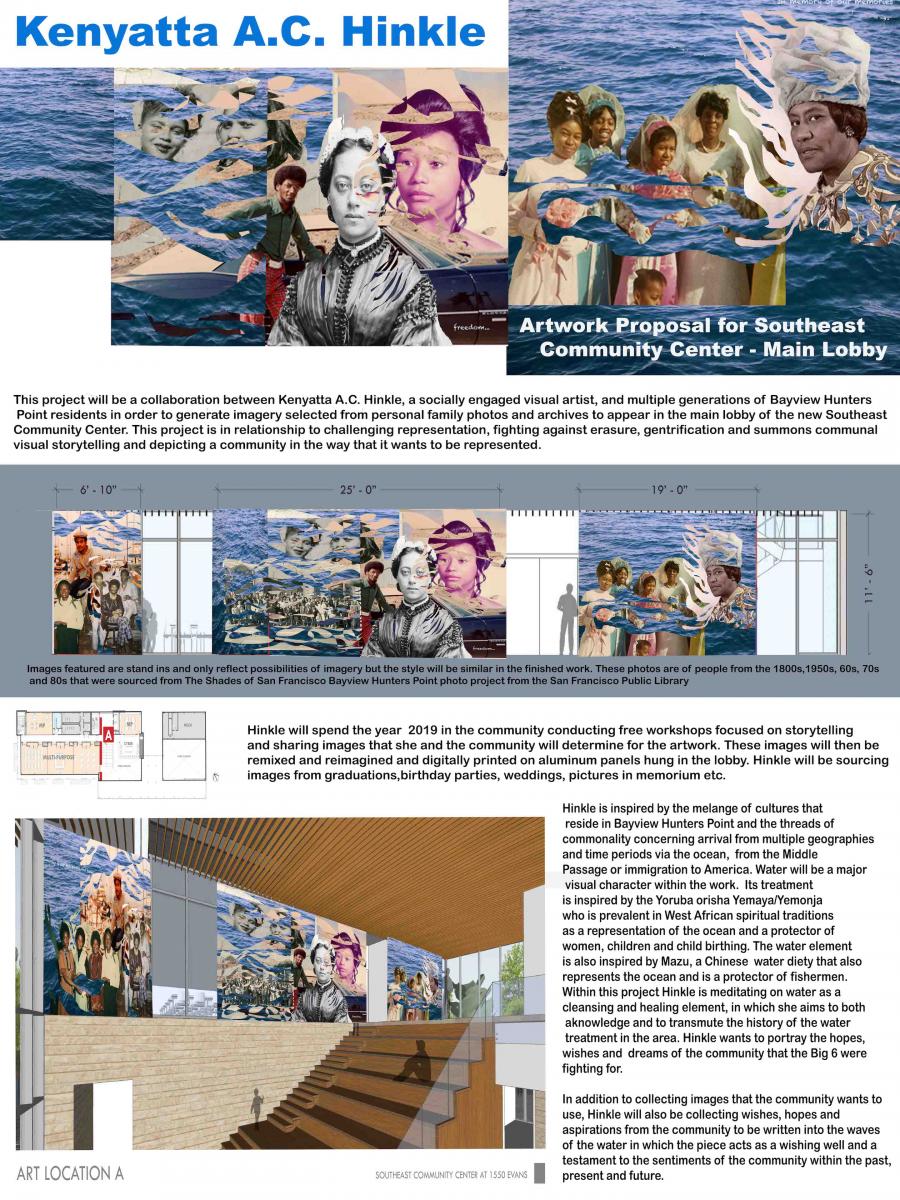 This project will be a collaboration between Kenyatta A.C. Hinkle, a socially engaged visual artist and multiple generations of Bayview Hunters Point residents in order to generate imagery selected from personal family photos and archives to appear in the main lobby of the new Southeast Community Center. Hinkle’s work centers around working with photographic archives in order to elevate the unknown and the unnamed in relationship to race, culture, colonialism, geographies and histories. This project is in relationship to challenging representation, fighting against erasure and rampant gentrification. This undertaking summons communal visual storytelling in order to depict a community in the way that it wants to be represented. Featured images in this proposal are stand ins and only reflect possibilities of imagery, yet the style and handling of the photos will remain the same. The photos are of people from the 1800s,1950s, 60s, 70s and 80s that were sourced from The Shades of San Francisco Bayview Hunters Point photo project from the San Francisco Public Library and from an archive of Black San Francisco. All of the images included in this mock-up have to do with immigration, traveling from a great body of water, contending with the history of crossing the water for better or worse and adapting to the conditions of a new land, yet thriving at the same time. It is a collage of The Historical Present. Hinkle will spend the year 2019 in the community conducting free workshops focused on storytelling and sharing images that she and the community will determine for the final artwork. These images will then be remixed and reimagined and digitally printed on 28 aluminum panels hung to create the murals in the main lobby. Hinkle will be sourcing images from graduations, birthday parties, weddings, pictures for remembering the transitioned and people who helped to shape Bayview Hunters Point. Hinkle is inspired by the everyday lives of people in the community. She wants to portray the hopes, wishes and dreams of the community that the Big 6 were fighting for. She would like to work with photographs of people from various ethnicities and cultural backgrounds (Though an emphasis will be placed on prominent African diasporic culture that is an anchor within Bayview’s history but it will not be restricted to one cultural community visually and content wise.)
This project will be a collaboration between Kenyatta A.C. Hinkle, a socially engaged visual artist and multiple generations of Bayview Hunters Point residents in order to generate imagery selected from personal family photos and archives to appear in the main lobby of the new Southeast Community Center. Hinkle’s work centers around working with photographic archives in order to elevate the unknown and the unnamed in relationship to race, culture, colonialism, geographies and histories. This project is in relationship to challenging representation, fighting against erasure and rampant gentrification. This undertaking summons communal visual storytelling in order to depict a community in the way that it wants to be represented. Featured images in this proposal are stand ins and only reflect possibilities of imagery, yet the style and handling of the photos will remain the same. The photos are of people from the 1800s,1950s, 60s, 70s and 80s that were sourced from The Shades of San Francisco Bayview Hunters Point photo project from the San Francisco Public Library and from an archive of Black San Francisco. All of the images included in this mock-up have to do with immigration, traveling from a great body of water, contending with the history of crossing the water for better or worse and adapting to the conditions of a new land, yet thriving at the same time. It is a collage of The Historical Present. Hinkle will spend the year 2019 in the community conducting free workshops focused on storytelling and sharing images that she and the community will determine for the final artwork. These images will then be remixed and reimagined and digitally printed on 28 aluminum panels hung to create the murals in the main lobby. Hinkle will be sourcing images from graduations, birthday parties, weddings, pictures for remembering the transitioned and people who helped to shape Bayview Hunters Point. Hinkle is inspired by the everyday lives of people in the community. She wants to portray the hopes, wishes and dreams of the community that the Big 6 were fighting for. She would like to work with photographs of people from various ethnicities and cultural backgrounds (Though an emphasis will be placed on prominent African diasporic culture that is an anchor within Bayview’s history but it will not be restricted to one cultural community visually and content wise.)
Hinkle is inspired by both the mélange of cultures that reside in Bayview Hunters Point and also the threads of commonality concerning arrival from multiple geographies and time periods via the ocean, whether through The Middle Passage or immigration to America. Water will be a major visual character within the work. Within her research in relationship to what she learned about the history of the waste water treatment plant, the trauma of the mid-Atlantic slave passage, The Great Migration to California, immigration, boundary crossings, and Chinese fishermen who lived in Bayview, Hinkle began thinking about the spirituality of water. Hinkle is meditating on this concept of water as a cleansing and a healing element in which this project is an aim to transmute the history of the water treatment in the area. Hinkle is conceptually thinking about the digesters and what if they could digest and cleanse things energetically from the past, present and future. She wants to work with the essences of Mazu, a Chinese water goddess and Yemonja/Yemaya, a Yoruba orisha that represents the ocean and is the protector of children, families, and child birthing. Yemonja/Yemaya is reflected in Yoruba West African cultural traditions as well as Caribbean and Latin American cultural communities. The presence of these maternal figures as the ocean will conjure up their energy and narratives. During her socially engaged residency she wants to conduct free storytelling workshops, artmaking and image collecting. Hinkle wants to collect data that is two-fold.
1) Ideas and experiences that the community wishes to be cleansed and healed by the water.
2) Elements that the community want to be amplified or nourished by the water in order to bring in abundance.
These ideas would be incorporated into the waves in which the entire commission acts as a wishing well of sorts. Through working with local artists, elders and youth in the community for a year to collect images, wishes, symbols and motifs that will be represented in the water, these words will be written and rendered in silver iridescent coloring so that they look like coins that one may throw intro a wishing well. There will be hand written elements that will also include text written in the multiple languages spoken in the community. It is possible for the Big 6 to appear in the work as water pourers or carriers that will be woven into abstract compositions. The central image on the 25ft long portion of the mural will act as a protector for the community and the entire space.
View a larger image of the proposal.
Pattern Participation
Sanaz Mazinani
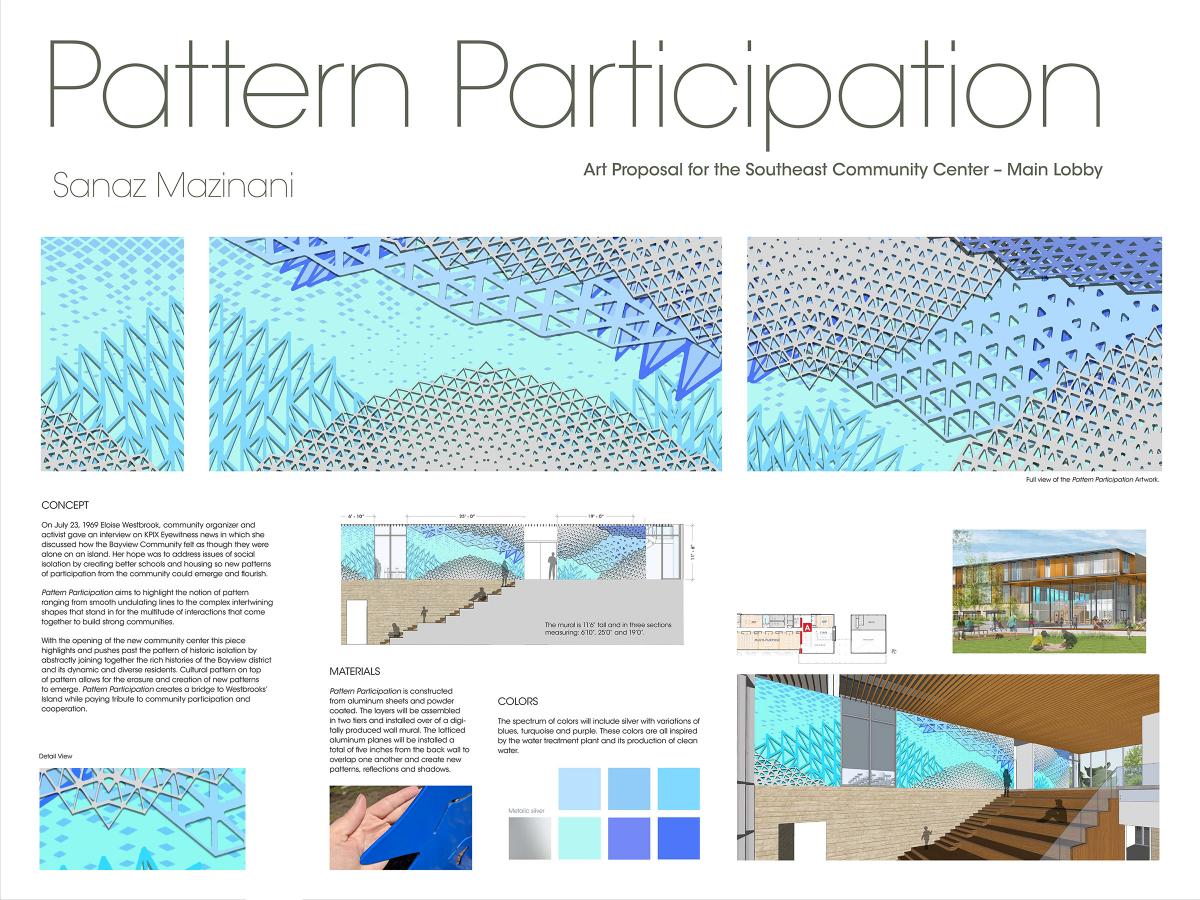 On July 23, 1969 Eloise Westbrook, community organizer and activist gave an interview on KPIX Eyewitness news in which she discussed how the Bayview Community felt as though they were alone on an island. Her hope was to address issues of social isolation by creating better schools and housing so new patterns of participation from the community could emerge and flourish.
On July 23, 1969 Eloise Westbrook, community organizer and activist gave an interview on KPIX Eyewitness news in which she discussed how the Bayview Community felt as though they were alone on an island. Her hope was to address issues of social isolation by creating better schools and housing so new patterns of participation from the community could emerge and flourish.
Pattern Participation aims to highlight the notion of pattern ranging from smooth undulating lines to the complex intertwining shapes that stand in for the multitude of interactions that come together to build strong communities.
With the opening of the new community center this piece highlights and pushes past the pattern of historic isolation by abstractly joining together the rich histories of the Bayview district and its dynamic and diverse residents. Cultural pattern on top of pattern allows for the erasure and creation of new patterns to emerge. Pattern Participation creates a bridge to Westbrooks’ Island while paying tribute to community participation and cooperation.
MATERIALS
Pattern Participation is constructed from aluminum sheets and powder coated. The layers will be assembled in two tiers and installed over of a digitally produced wall mural. The latticed aluminum planes will be installed a total of five inches from the back wall to overlap one another and create new patterns, reflections and shadows.
COLORS
The spectrum of colors will include silver with variations of blues, turquoise and purple. These colors are all inspired by the water treatment plant and its production of clean water.
View a larger image of the proposal.
For more information,
Please contact: mary.chou@sfgov.org, or (415) 252-2233.
Materiales traducidos están disponibles para usted de manera gratuita. Para asistencia, notifique a mary.chou@sfgov.org, or (415) 252-2233.
我們將為閣下提供免費的書面翻譯資料。 如需協助,mary.chou@sfgov.org, or (415) 252-2233.
Ang mga materyales na nakasalin sa ibang wika at ang mga serbisyong tagapagsalin sa wika ay walang bayad. Para sa tulong, maaring i-contact si mary.chou@sfgov.org, or (415) 252-2233.
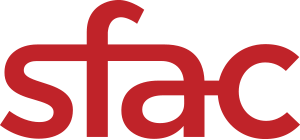
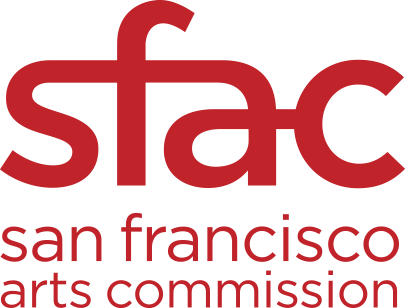

Opportunity For Public Comment
Please take a few minutes to review these artwork proposals and provide feedback on the public comment form below. Public comments will be considered by the Selection Panel as part of the Final Selection Panel meeting where the Panel will recommend one proposal for implementation. Please note that public comments do not constitute a vote.
The Final Selection Panel meeting will take place Friday, November 2, 2018, 9 a.m.–4:00 p.m. at 401 Van Ness Avenue, Room 302. All Artist Selection Panel meetings are open to the public. An agenda for the meeting will be posted 72 hours in advance of the meeting on SFAC’s website under the Public Meeting section: www.sfartscommission.org.
The proposals are available online at www.sfartscommission.org/calendar, in the Public Art Proposal Display section. Comments may be emailed to sfacpublicartcomment@sfgov.org, or hand delivered/mailed to 401 Van Ness Avenue, Room 325 by Wednesday, October 31, 2018 at 5:00 p.m.